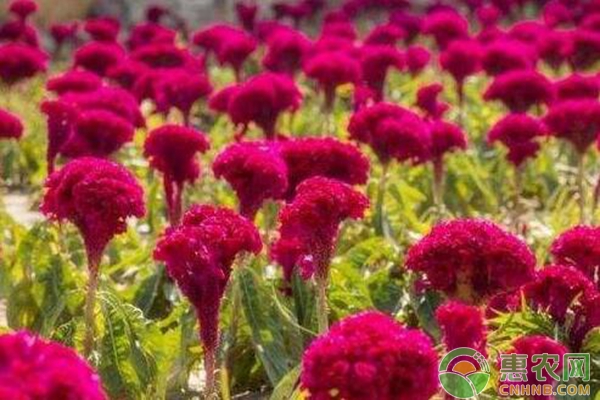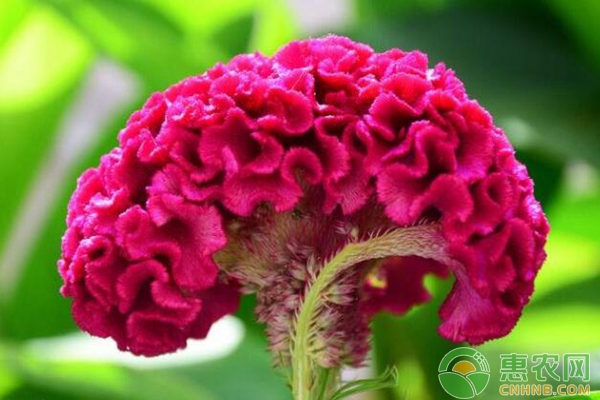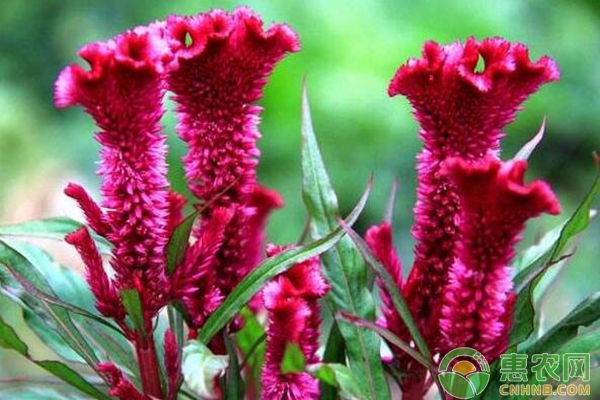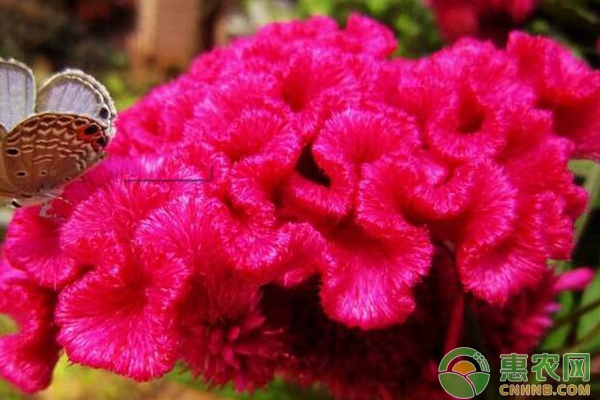The cockscomb is aliased to the cockscomb, red cockscomb, and chicken cockscomb. It is named after the inflorescence twisted and folded like a cockscomb. "Compendium of Materia Medica" records: the cockscomb "indications leaked blood, red and white sputum, collapse in the red and white belt, divided into red and white." "Yu æª è§£ solution" also cloud: "treatment of vomiting blood, blood collapse, blood leaching blood loss Certificate." Chinese medicine believes that cockscombs are sweet, cool, with cooling blood, hemostasis, stop, stop phlegm, stop dripping and other effects, can be used to treat functional uterine bleeding, intestinal wind and other diseases.
In recent years, some scholars have analyzed the cockscomb flower: it is rich in nutrients such as protein, fat and folic acid, vitamin B1, vitamin B2, vitamin B., vitamin B12, vitamin C, vitamin D, vitamin E, vitamin K. 21 kinds of amino acids, 13 kinds of trace elements and more than 50 kinds of natural enzymes. China has been widely planted in the Ming Dynasty and has become a recognized famous flower. The following describes the cultivation techniques of cockscombs.

Cockscomb distribution and characteristics
The cockscomb is an annual herb of the genus Asteraceae. It can be planted in most areas of China. The cockscomb has strong adaptability and high yield. It can make full use of the idle land planting in front of and behind the house, which can beautify the environment and increase farmers' income.
Cockscombs generally have a plant height of 30 to 90 cm.
Stems erect, upper flat, red or green, ribbed longitudinal groove, few branches.
Leaves alternate, ovate-lanceolate or linear-lanceolate. Leaf color often has different colors such as green, yellowish green, reddish or red and green.
The top fleshy spikes are mostly flat, resembling a cockscomb, and most of the florets are concentrated below the middle. The perianth is membranous, the upper part is degenerated, and there are feathery bracts, dark red, blush, yellow, white and complex colors.
The ovary is spherical, the fruit is oval, and the seeds are black and shiny.

Celosia planting technique
Land selection
The nutrition of Chinese medicinal plants mainly comes from the soil. Therefore, when selecting the Chinese medicinal planting base, not only the adaptability of the medicinal materials to ecological and climatic conditions, the fertility status of the soil, the fertilization characteristics, but also the content of heavy metals and toxic elements in the soil should be considered. Should meet the standards set by the state.
The main pollutants in the air, sulfur dioxide and nitrogen oxides, do not exceed the secondary standard specified in the national ambient air quality GB3095-1996. The indicators for irrigation water should meet the quality standards for farmland irrigation water.
The cockscombs prefer warm, dry climate, fear of drought, sunshine, and suffocation, but the soil requirements are not strict, so the general soil can be planted.
2. Land cultivation
Because the cockscomb is densely planted, it is very inconvenient to fertilize in the growing season. Therefore, after the land is selected, more base fertilizer should be applied. Generally, 1/15 hectare (per mu) can be applied with organic fertilizers such as compost, manure or smoldering soil of 1500~2000 kg. . Note: It is necessary to increase the application of base fertilizer, banned nitrate nitrogen fertilizer, municipal solid waste, industrial waste and hospital waste and manure.
Spread the base fertilizer evenly on the ground, and then carry out deep tillage. The general depth of cultivation is about 25 cm.
After deep turning, it should be done according to the topography and climatic conditions. The flat terrain can be used for growth. The ups and downs can be used as short rafts. In the south, more rainwater can be used as sorghum, which is good for drainage, and less rain can be used as a flat in the north. . Generally, the width is 100~150 cm.
After the cockroach is done, in order to increase the germination rate of the seeds, the land should be watered and collapsed, and after the soil is dry, the soil is turned over. Before the floor is turned over, 3% potassium phosphate granules can be applied to prevent the underground pests from harming the seeds and affecting the germination rate.
The land should not be too deep, usually 5 to 6 cm, and then leveled, so that the land can be planted at any time.
After ploughing, it is repeated. To make the clods fine, be sure to flatten them. Preventing the clods and debris from being embedded in the scorpion affect the germination and root growth of the cockscomb.
3. Seeding and breeding
The cockscombs are generally propagated with seeds. Before sowing, the seeds should be screened to remove impurities and damaged seeds to ensure the purity and germination rate of the seeds.
Then soak the seeds in water for 12~24 hours, remove them and dry them in a ventilated and dry place. This will allow the seeds to be internally metabolized, enhance the vigor of the seeds and increase the germination rate.
The seeds of the cockscomb are small, so that the seeds can be more evenly sown, the seeds are not too dense, and the seeds are wasted. When the surface of the seeds is waterless, the appropriate amount of fine sand or fine soil is mixed, and the ratio of seeds to sand is generally 3:1. Then, after mixing, the seeding can be carried out.
Use the tool to open the ditch on the raft. Generally, the groove distance is about 20 cm, and the groove depth is about 5 cm.
Sprinkle the seeds into the ditch, usually about 1 in 15 hectares (per mu).
After sowing, cover the soil about 3 cm. Use your feet to be a little bit solid, and then use iron shovel to make the seeds in close contact with the soil. Pay attention to shallow sowing, pay attention to watering after sowing, keep the soil moist in the surface, it is conducive to emergence. After sowing, the ground temperature should be about 10~15 days at 16~18°C. If the ground temperature is 19~25°C, the humidity is suitable. It takes about 1 week to emerge, and the soil should be kept moist before and after emergence.

4. Field management
Although the growth of cockscomb is greatly affected by the environment, its economic yield and quality of medicine depend on the level of field management. Therefore, strengthening field management plays an important role in ensuring the high quality and high yield of cockscomb flowers.
(1) Management of seedling stage
Cultivating weeding
The key measure for the growth and development of cockscomb is cultivating and weeding, mainly to loosen the soil, increase the ground temperature, regulate soil moisture, and eliminate weeds, so as to promote root development and ensure the robust growth of cockscomb seedlings.
In the seedling stage of Celosia chinensis, the words "early, shallow and fine" should be highlighted. "Early" means that the seedling should be cultivated in time; "shallow" means that the depth of cultivating should not exceed 5 cm to prevent root damage and injury. Run picking; "fine" refers to the depth and consistency of the cultivating, the soil is loose and fine.
When the seedling height is about 5 cm, use a small hoe to loosen the soil and cut the ground to prevent the seedlings from hurting the roots. Do not water the seedlings during their unearthing. If it is too dry after emergence, it should be poured with small water to maintain soil moisture.
Miao Ding Miao
When the seedling height is 6~10 cm, the dense seedlings and seedlings are too dense. When the seedling height is 10~15 cm, the seedlings are 10~15 cm and the seedlings are 2~3 strains. If there are missing seedlings, the large seedling-like seedlings should be transplanted with soil. When transplanting, avoid strong sunlight. It is best to choose a cloudy day. When transplanting the seedlings, try to bring the original soil as much as possible. After replenishing the seedlings, water them in time to facilitate the survival of the seedlings.
Fertilization
The cultivar needs more nitrogen fertilizer in the seedling stage. In order to have more stalks and stalks, the phosphorus and potassium fertilizers should be properly applied. When the seedling height is about 15 cm, fertilization is carried out, and some fertilizer is sprinkled between the lines, and 1/15 hectares (per mu) is applied with 10 to 15 kg of urea and 25 to 40 kg of cake fertilizer.
Seedling period should be watered frequently to facilitate growth, and the ability to resist drought after planting is enhanced, but avoid water sputum. If there is too much rain, the water should be removed in time.
(2) Management of the growing season
Cultivating weeding
Always pay attention to weeding and weeding, keep the soil loose without weeds in the field, usually once every 20 days, or as the case may be, the sowing is inconvenient, so we only require weeding, or appropriate tillage 1~2 times, generally sealed After the trip, it is inconvenient to loosen the soil. The loose soil should be shallow to avoid root damage. The cultivating should be carried out when the soil moisture is moderate.
Fertilization and irrigation
When the seedling height is 20 cm, 10 kg of potassium chloride is applied, and the ditch is applied and applied. When the seedling height is more than 30 cm, 1/15 hectare (per mu) is applied with 60 kg of decomposed cake fertilizer, and a small amount of phosphorus and potassium fertilizer can be applied.
After the cockscomb enters the growth period, the drought resistance of the adult plants is enhanced, and generally no watering is allowed. It is not raining in summer, the soil water content is below 8%, and the plants should be watered when they are wilting. Each watering should not be excessive, it should be lightly poured.
Before the arrival of the rainy season, attention should be paid to drainage and flood control. The cockscomb is most afraid of water in this period. If there is too much rain, the water in the field should be drained in time to avoid causing disease.
(3) Management in the later stage of growth
According to the investigation of the growth of cultivated cockscombs, the growth of the plots and the yield and quality of the medicinal materials are not as good as natural growth. Therefore, the cockscombs for the purpose of harvesting medicinal materials are generally not subjected to field operations management in the late growth stage, so that they are in a semi-wild state, which can inhibit the reproductive growth of cockscombs, facilitate vegetative growth, and improve the yield and quality of medicinal materials.

Pest Control
The control of cockscomb pests and diseases is crucial, but in the prevention and control of pests and diseases, the abuse of pesticides, overdose, and incorrect pesticide application methods are widespread, resulting in excessive levels of heavy metals in Chinese herbal medicines and declining medicinal quality. Because the quality of pest control is related to the yield and quality of cockscomb, it must not be relaxed.
(1) Black spot disease
Symptoms: Black spot disease can damage the leaves, petioles, twigs and pedicels of plants, but mainly damage the leaves of plants. At the beginning of the disease, the surface of the leaves showed reddish-brown to purple-brown spots, which gradually expanded into round or amorphous dark black lesions. There were often yellow halos around the lesions, and the edges were radial. The lesions were about 3 to 15 mm in diameter.
The black spots on the late lesions are scattered, that is, the conidia discs of the bacteria. In severe cases, the leaves of the lower part of the plant are yellow and early leaves, causing individual branches to die.
Control method:
1 Use excellent disease-resistant varieties.
2 After the autumn, the dead branches and fallen leaves are removed and burned in time.
3 Strengthen cultivation management, pay attention to plastic trimming, ventilation and light transmission. 4 In the early stage of the disease, it can spray 50% carbendazim WP 500~1000 times solution, or 75% white bacterium clear 500 times solution, or 80% daisen zinc 500 times solution, once every 7~10 days, even spray 3~4 times.
(2) Powdery mildew
Powdery mildew is mainly caused by the leaves of plants. In the early stage of the disease, the white nearly round to irregular blister on the back of the leaf, that is, the spore heap. Its surface is slightly lustrous, and there are dozens of blister spots on one leaf. The mature blister epidermis ruptures, and the white powder is not scattered, which is the spore attack of the pathogen.
Method of prevention : After harvesting, the diseased plants in the Qingyuan Garden are burned or deeply buried, sprayed with 1:1:120 Bordeaux mixture or 50% methyl thiophanate WP 1000 times, sprayed once every 10~14 days, continuous spraying 2~3 times.
(3) Root rot
Symptoms : Root rot mainly affects the roots and roots. At the beginning of the disease, the diseased part was brown to dark brown, gradually rotted, and the outer skin fell off, leaving only the xylem, and the vascular bundle browning was observed. When the humidity is high, the patient comes out with a layer of white to pink hyphae. The upper part of the leaves is yellowed or the branches are compiled. In severe cases, the branches or the whole forest are dead.
Control method : The diseased forest was found to be excavated in time, the plant was planted, and the lime was disinfected in the diseased area. If necessary, it could be replaced with new soil. In the early stage of love disease, spray 50% methyl sulphur WP 1500 times solution or 4% dysen iron solution 500 times solution, 20% lycopene emulsifiable concentrate 1000 times solution. After one and a half months, it can be cured.
(4) Underground pests
Underground pests refer to a class of hilarious insects that live in the soil during the hazard period, mainly including the station, the genus, the tiger, and the golden worm. There are many kinds of such pests. They mainly feed on the seeds, roots, stems, roots, tubers, seedlings and young leaves of crops, which affect the growth of crops.
Control method : the prevention and control of underground pests is mainly carried out by manual killing, cutting fresh grass into small sections, mixing with 50% zinc sulphur-phosphorus emulsifiable concentrate 0.5 kg into poisoning and smothering: or putting the paulownia leaves with the trichlorfon liquid in the evening Field trapping; can use 80% babies WP 100g, add a small amount of water and stir-fry bran 5kg, in the evening, apply: 40%~50% Lego emulsifiable concentrate 100ml water 5kg mixed 50kg fry To the fragrant bait (wheat bran, bean cake or corn granules, etc.), create a large bowl of pit every 2 to 3 meters, put a poison bait and cover the soil, 1 / 15 hectares (per mu) with feed 1.5~ 2 kg, the safety interval is 7 to 10 days.
(5) Rats
Rodent damage is another major hazard in the cultivation of cockscombs. Therefore, it is especially important to control rodents. Prevention and control of rodents must adhere to “prevention first, comprehensive prevention and control†in order to receive good control effects.
Control method:
1 poison bait prevention method: bait consists of bait and rodenticide. When preparing poisoning, a small amount of vegetable oil, sugar, etc. may be added to improve the palatability of the rats when eating. The concentration of the poison should be prepared, and the concentration of the drug should be appropriate, and the concentration of the medicament used for the wild rats should be trapped. The concentration of the agent used to kill the house mouse is higher.
2 Poisonous water prevention and control method: Poisonous water is composed of rodenticides, which are often used in some places where water is scarce, or around rodent drinking places. Poisonous water is usually placed in shallow basins.
3 Toxic powder prevention and control method: Toxic powder uses the habit of rodent in the mouse, and puts toxic powder around the mouse hole or where it is often active, so that the mouse hair sticks to the venom powder, and then the mouse hair is caused by rodent poisoning. death.

Cockscomb harvesting and processing
The seeds of the cockscomb gradually become black and mature, and the flowers can be cut off in time, and the clothes are dried in the air. When they are exposed to the sun, they should be taken out early and not exposed, so as not to deteriorate and reduce the efficacy, and then bagging and storing.
Hair Wash Shampoo,Natural Shampoo,Hair Nourishing Shampoo,Ginger Hair Shampoo
Wuxi Keni Daily Cosmetics Co.,Ltd , https://www.kenicosmetics.com